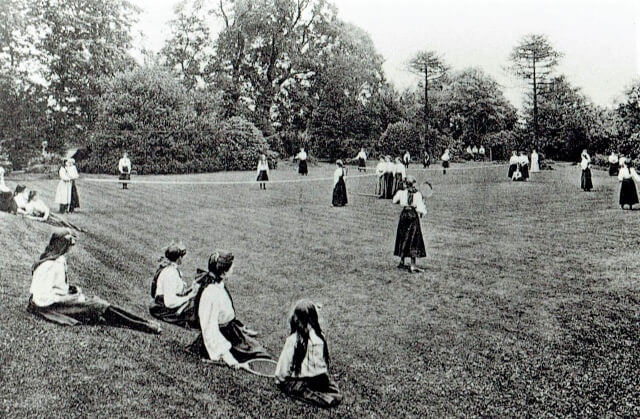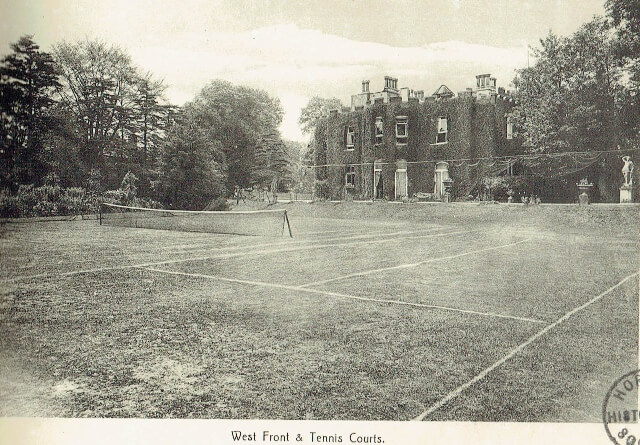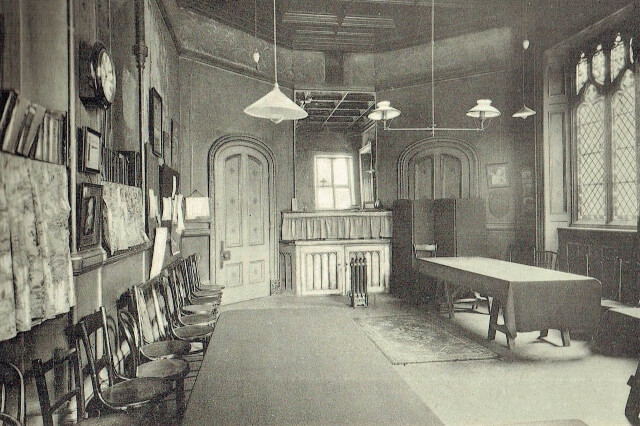After the departure in 1905 of the last occupants, John Cathles Hill and family, the house became a girls’ school run by the Misses Rowe who moved to it from Sussex House, Bishopswood Road, Highgate. Their school was ‘for the daughters of Gentlemen’. Here are memories of the school published in early HHS Bulletins.

Interviews taken from HHS Bulletin 13, Spring 1977.
In November 1976, Sylvia Bond interviewed ‘the Dale sisters’ who lived in Muswell Hill Road and who had attended Southwood Hall School; Nora from 1908 to1913 and Constance from 1918 to 1924. This is what Sylvia recorded:
‘The school had girls from the age of 11 to 18. Nora was 12 when she started and Constance 10. The school motto was ‘Right is Might’. The house was beautiful with a fine entrance hall and cloakrooms and lockers at the end. The dining room was beautiful too. Miss Rowe, the headmistress, had her drawing room overlooking the gardens with her bedroom above. In the basement were two very old arched cellars which were used as cloakrooms. It was rumoured that there was an underground tunnel from there through Southwood Lane to the Toll House.

The gardens were spacious and beautiful. There were tennis courts, a specially built drill hall and way beyond, down some steps, was a netball court. In the lower part of the garden towards Muswell Hill was a wooden building used as an art room. Miss Rowe was artistic and highly educated. She taught the history of art and architecture and gave religious instruction in Nora’s day. She took parties of girls to visit the art galleries in Florence, Rome and Venice. Constance thought Miss Rowe was about 80 (post-1918) and a frightening old lady.
The school was Church of England. Before 1914 the then Vicar of St Michael’s, Rev. Wilfrid Ogle, gave religious instruction several times a year. There was a French teacher and a Fraulein Berg taught German before 1914. Musical theory, piano and violin lessons were given. Miss Edith Rowe, the headmistress’s sister, taught art and was a good teacher. The girls painted in watercolour and drew from still life. Miss Powell, the gardener, took girls for nature study lessons in the garden.
Before 1914 Miss Wyman, who was a very good teacher, took English, geography, history and grammar. She married a headmaster when she was about 40 years old. Miss Wardroper, who replaced Miss Wyman, taught Constance geography. She was a keen Liberal. Miss White, who was qualified, taught mathematics.

In Nora’s day a Miss Doris Wilson used to take tennis, netball and gymnastics. Nora was in the gym team of eight girls. The team wore red braid sashes round their tunics. The drill hall was the gymnasium with climbing frames down the side wall, rings and ropes. At the far end was a stage which was used for plays and concerts. The tennis was good. The school played matches against Channing House and North London Collegiate School. Miss Nordquist was new and young and taught gymnastics, barefoot dancing and games when Constance was at school after 1918.
Miss Nellie Sargent took elocution and taught it very well. She was responsible for the production of plays. Her sister, Miss Amy, taught singing. Nora thought that putting on annual plays in the grounds may have been unusual in those days. There was singing and dancing in the plays. Nora took leading roles in both A Midsummer Night’s Dream and Comus.
The school blazer had green and yellow stripes. In winter the girls wore velour hats with stripped ribbons and in the summer sported straw boaters. They wore black stockings and tunics for gym. The girls were taught good manners. They were not, in general, expected to take up careers but to get married. They were not prepared for the outside world and had to learn by experience when they left school.

Some girls sat Junior and Senior Cambridge examinations and some were prepared for University Entrance if they were going to have an academic career or wanted to further their education. In Nora’s day the head girl, Sally Thompson, and Margaret Fitzgerald took Somerville Entrance. Marjorie became a doctor and Sally a teacher.
Before 1914 there were about 20 boarders and 80 day girls with a housekeeper and staff. There were no boarders after The Great War but still about 80 day girls with an average ten in a class. The school was well thought of in the neighbourhood. After Constance left in 1924 she did not hear of any new girls starting at Southwood Hall’.
Recollection taken from HHS Bulletin 17, Summer 1978.
Edwin Monk, whose book, Memories of Hornsey, was the first HHS publication, recalled,
‘I had the pleasure, many years ago, of meeting Miss Rowe at the school. She showed me over the Hall and pointed out the dark oak panelling in her study or office which afforded an excellent view of the grounds…Her brother, Mr Rowe, whom I had met on several occasions, looked after the business part and other affairs connected with the school, and lived on the premises’.
Website editor’s note
Southwood Hall was demolished in 1930 and replaced by several blocks of mansion flats of the same name, the main block occupying the grounds of the original house.
Image credits
HHS